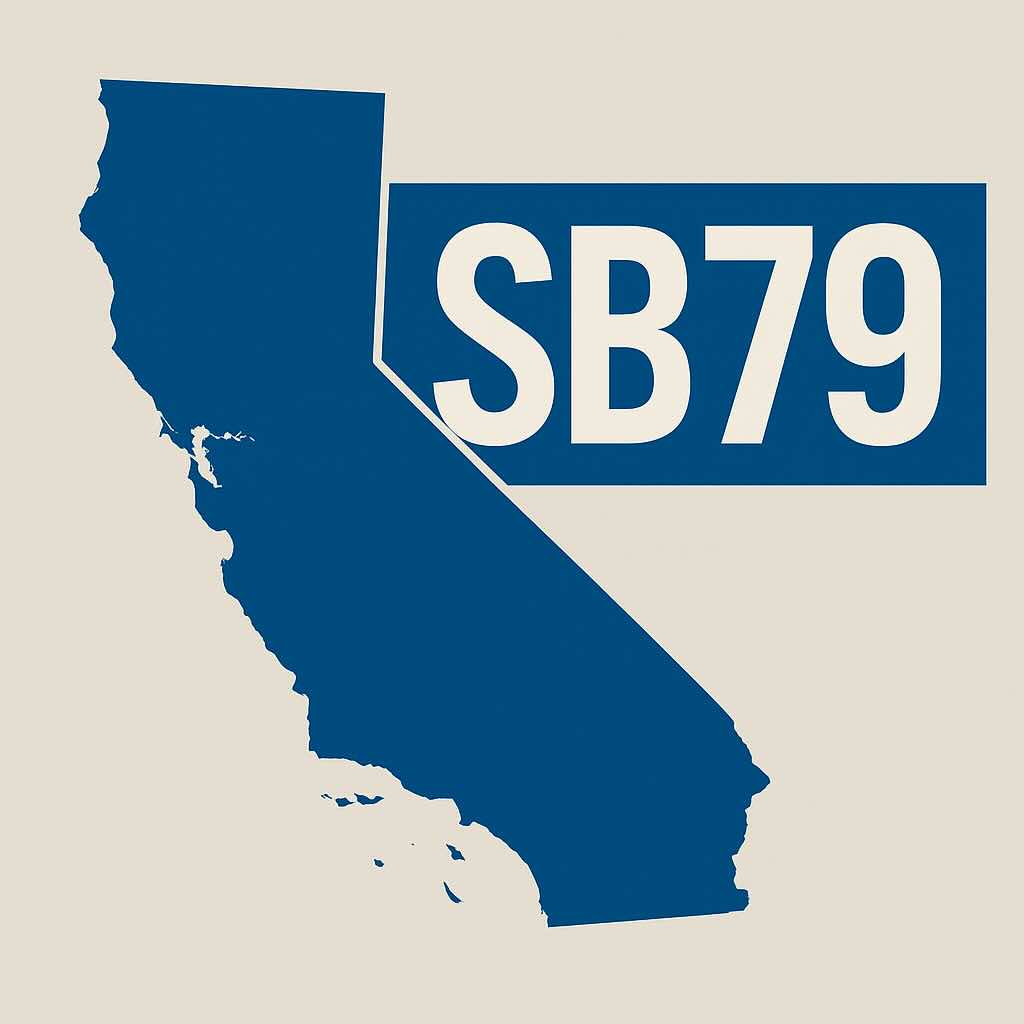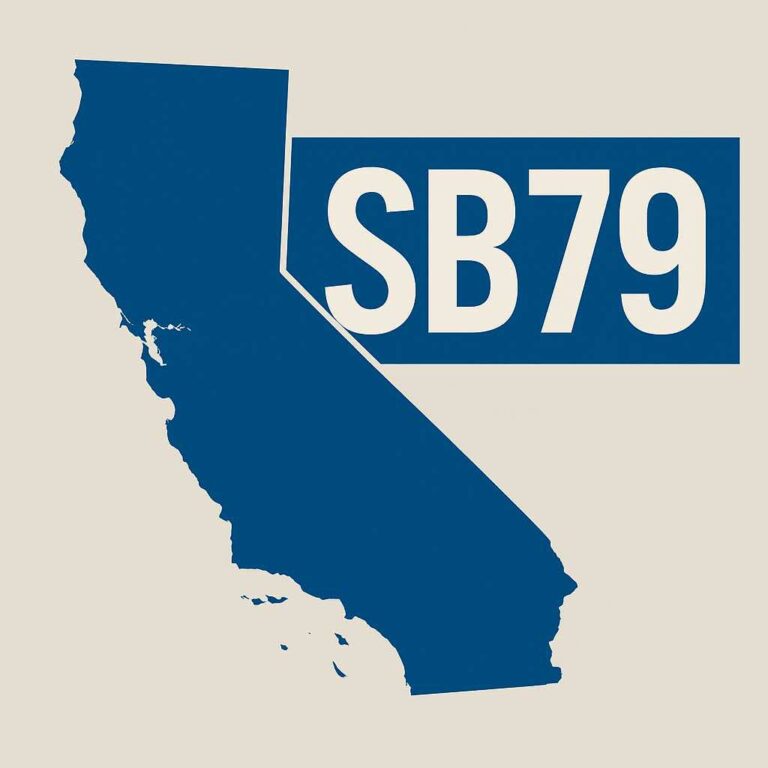Understanding California’s SB 79: A Major Breakthrough for Transit-Oriented Housing
Understanding California’s SB 79: A Major Breakthrough for Transit-Oriented Housing, At its core, SB 79 legalizes multi-family housing on land zoned for residential, commercial, or mixed use that lies within one-half mile of a major transit stop.

This means new homes can now be built near rail, subway, and rapid bus lines — areas where local zoning laws have long prevented density and housing supply growth.
On October 10, 2025, Governor Gavin Newsom signed Senate Bill 79 (SB 79), authored by Senator Scott Wiener, marking a historic moment in California’s housing reform landscape.
After nearly a decade of attempts — following the earlier SB 827 (2018) and SB 50 (2019-2020) — this new law finally delivers on the long-standing vision of transit-oriented housing reform in California.
What SB 79 Does
Key Provisions:
- By-Right Housing Approval: Streamlined, ministerial approval (under Government Code § 65913.4 — SB 35/SB 423) for qualifying projects, removing much of the red tape that slows down housing construction.
- Zoning Flexibility: Local governments cannot impose restrictive height caps, density limits, or floor area ratio (FAR) rules that would block new housing.
- Location-Based Development Tiers: Projects are prioritized based on transit quality — such as high-frequency rail or rapid bus lines.
In short, SB 79 makes it legal and faster to build multi-family housing near California’s most accessible and environmentally sustainable transit corridors.
Why SB 79 Matters
California is facing an extreme housing shortage. The state needs roughly 2.5 million new homes by 2030, yet only 100,000 permits were issued in 2023 — far below the annual goal of 180,000 homes.
At the same time, the median home price exceeds $900,000, requiring an income of about $237,000 per year, while the typical family earns just $96,500. Rents have also skyrocketed statewide — up 17% in Contra Costa County, 42% in Fresno, 21% in Los Angeles, and 37% in San Diego since 2020.
SB 79 directly addresses these pressures by unlocking areas near transit for higher-density housing — where residents can live, work, and travel affordably and sustainably.
Housing and Transit: Breaking the Cycle
SB 79 is designed to align housing growth with public transportation.
Currently, most new housing in California is built far from jobs and transit services, forcing long commutes and worsening traffic, pollution, and costs of living.
By legalizing homes near major transit stations, SB 79 reduces those burdens and supports transit system ridership — ensuring that the public investments Californians have already made in rail and bus systems actually serve more residents.
According to statewide research, a $230 increase in rent results in 22% fewer transit riders. By increasing supply near stations, SB 79 can help stabilize rents and sustain California’s transit systems financially and operationally.
Labor Standards and Equity Provisions
A key component of SB 79 is its balanced labor framework:
- Projects over 85 feet in height must meet prevailing wage and skilled/trained workforce standards, per SB 423.
- Smaller projects enjoy streamlined approvals without additional labor conditions — encouraging medium-density infill projects that are economically feasible.
- Transit agency-owned land developments are also subject to labor protections.
This compromise reflects lessons from prior housing bills (like AB 130 and SB 131, passed earlier in 2025) — striking a balance between labor rights and housing delivery.
Protecting Tenants and Ensuring Affordability
SB 79 includes strong tenant protection and affordability standards:
- No demolition of existing rent-stabilized buildings with 3+ units or properties occupied in the past 7 years.
- Minimum affordability requirements between 7% and 13% for subsidized homes.
- Incentives for deeper affordability through density bonuses tied to income levels.
These safeguards ensure that the bill promotes growth without displacement.
Local Government Flexibility
SB 79 still gives cities and counties flexibility through the creation of Transit-Oriented Development (TOD) alternative plans, provided they meet minimum statewide density goals.
Cities can phase in density over 2–3 years and request extensions in lower-resource areas to allow for community planning.
This approach blends statewide consistency with local control, helping cities adapt gradually while still meeting housing needs.
Fire Safety and Risk Mitigation
Recognizing California’s wildfire challenges, SB 79 includes a “fire flexibility” clause:
Local jurisdictions overlapping with very high fire severity zones have up to 3 years to adopt plans ensuring community protection.
They can also redirect density from fire-prone regions to safer areas, allowing housing growth without compromising safety.
Myths vs. Facts
Myth: SB 79 will eliminate local control.
Fact: Cities retain design, permitting, and fee authority — but can’t block housing purely based on height or density near qualified transit stops.
Myth: SB 79 forces high-rises everywhere.
Fact: Height limits vary by transit type and proximity — from 4 to 9 stories — and apply to less than 1% of all transit stops statewide.
Myth: SB 79 doesn’t include affordability.
Fact: Every SB 79 project must include affordable units, with options for higher percentages through density bonuses.
The Broader Impact
SB 79 unites California’s housing, transportation, and climate goals — creating more homes in high-demand, transit-rich neighborhoods like San Francisco (BART), Los Angeles (Metro & G Line BRT), and San Diego (MTS Trolley).
More homes near transit mean:
- Lower housing costs.
- Reduced traffic and pollution.
- Better access to jobs, schools, and services.
- Stronger, more sustainable communities.
Key Supporters and Partners
SB 79’s success is the result of years of advocacy by housing, environmental, and equity organizations, including:
- California YIMBY
- Bay Area Council
- Streets for All
- SPUR
- Greenbelt Alliance
- Inner City Law Center
- Abundant Housing LA
Senator Scott Wiener called SB 79 “eight years in the making,” crediting these partners for their political courage and commitment to solving California’s housing crisis.
The Bottom Line
SB 79 makes it legal, faster, and fairer to build more homes near California’s best public transit systems.
It removes outdated local barriers, protects renters, respects workers, and gives cities flexible paths toward compliance — all while bringing the state closer to its 2.5 million-home goal.
This is a long-awaited step toward a more sustainable, affordable, and connected California.



